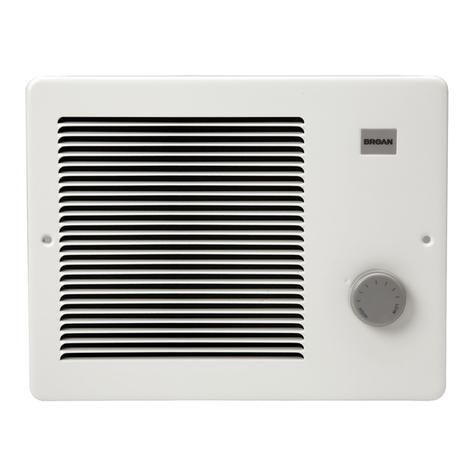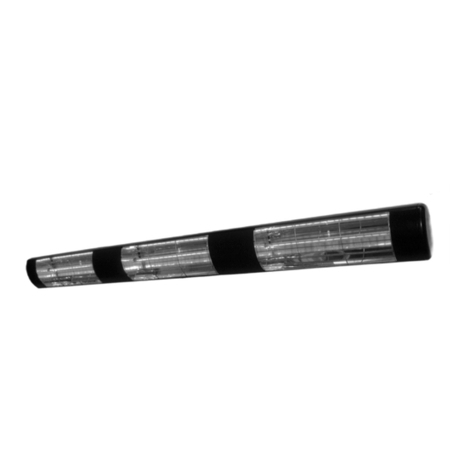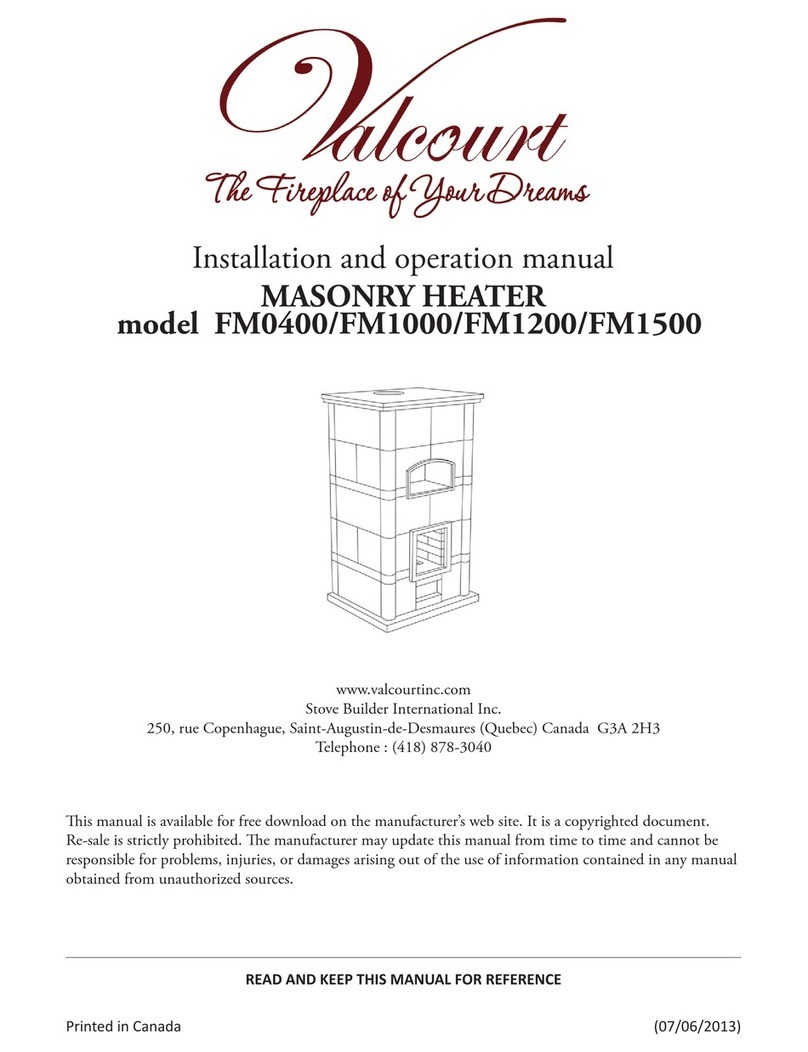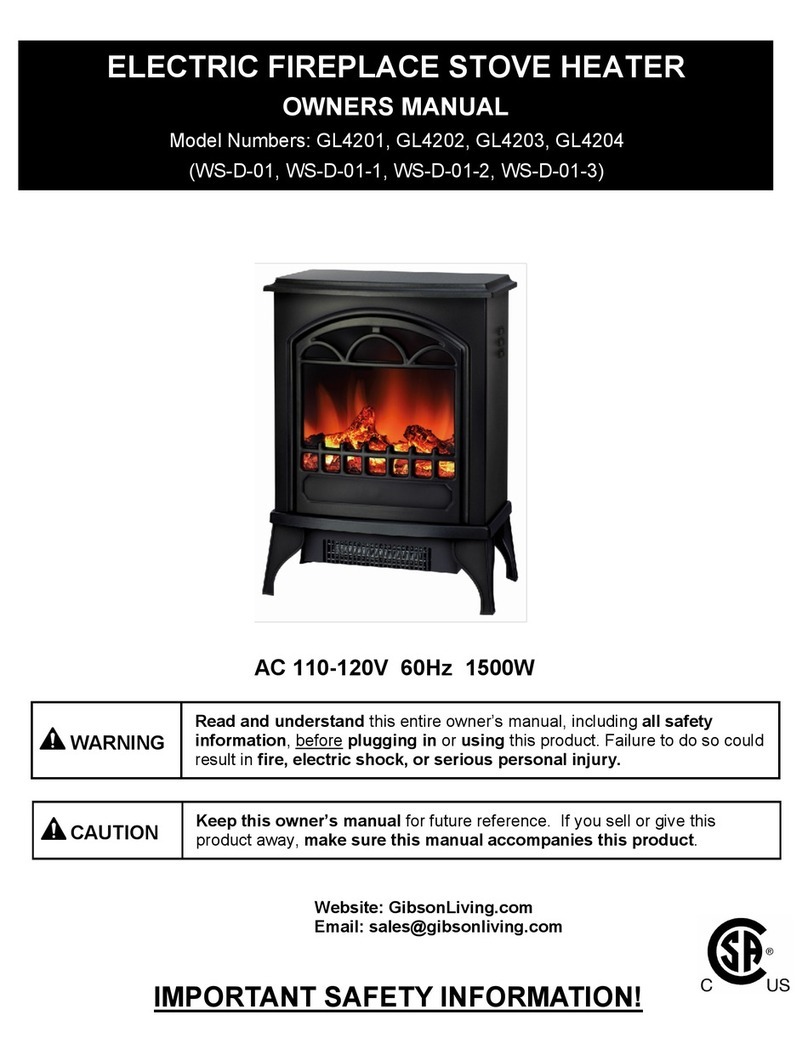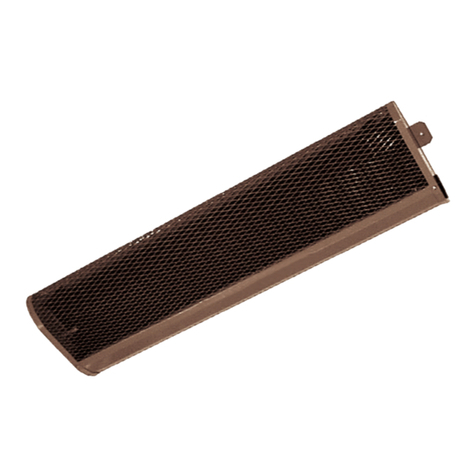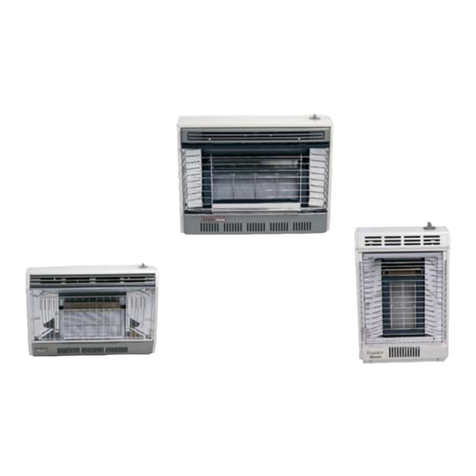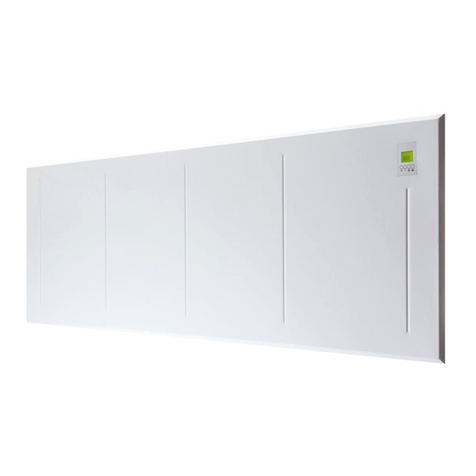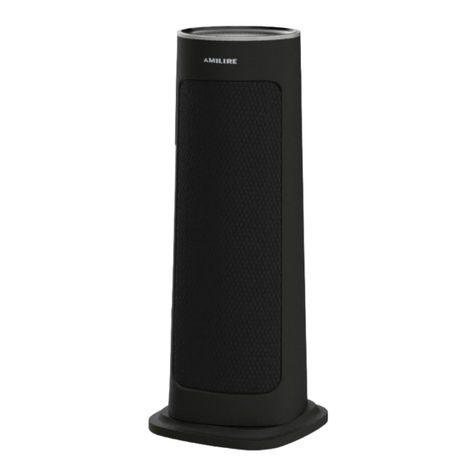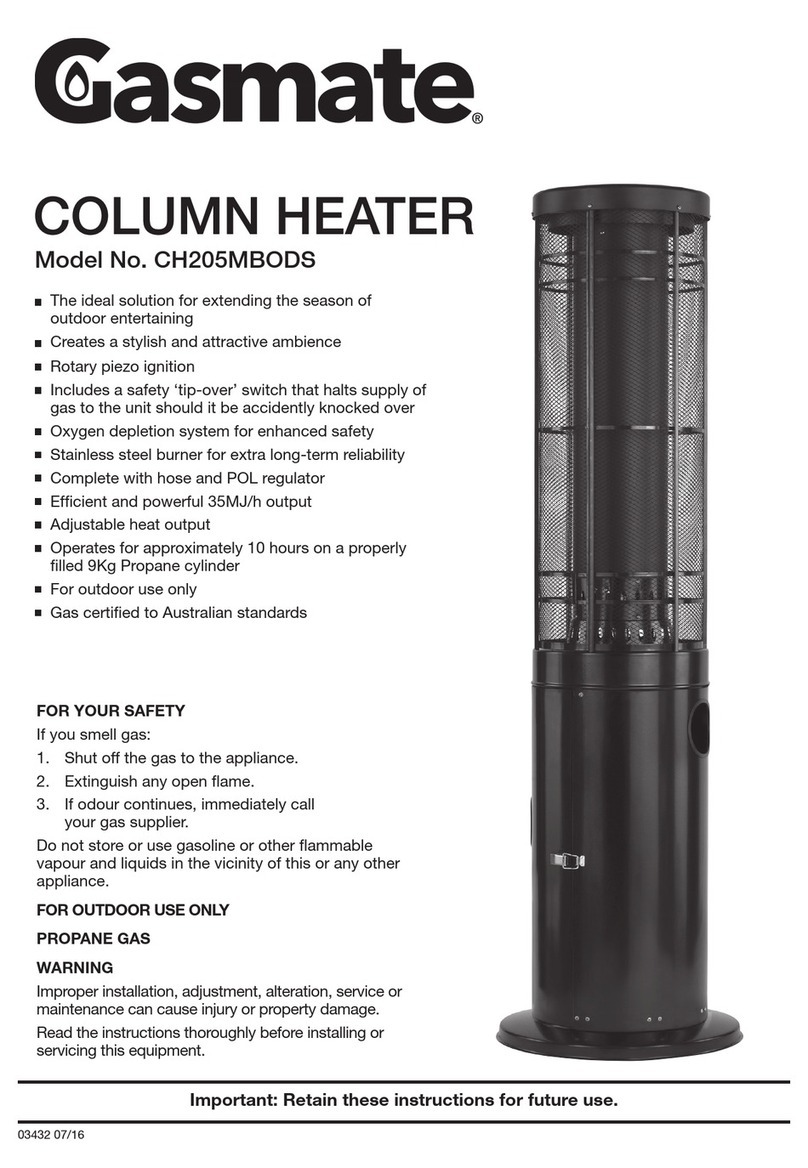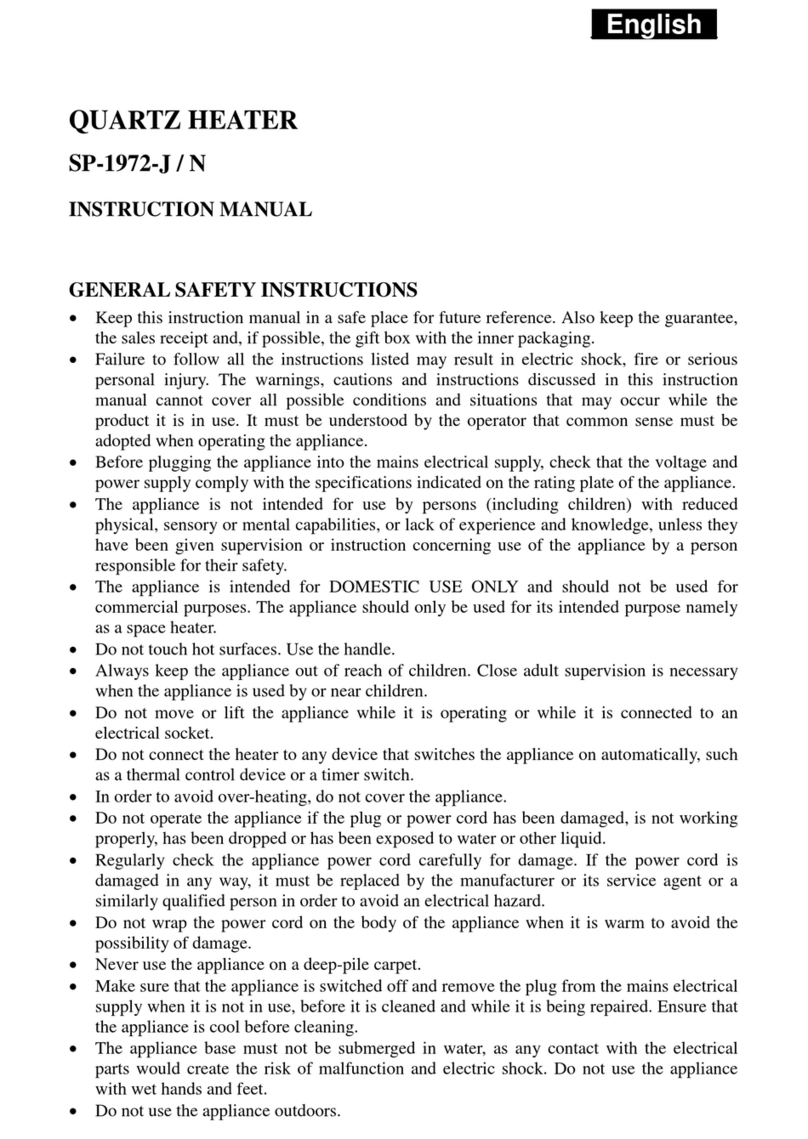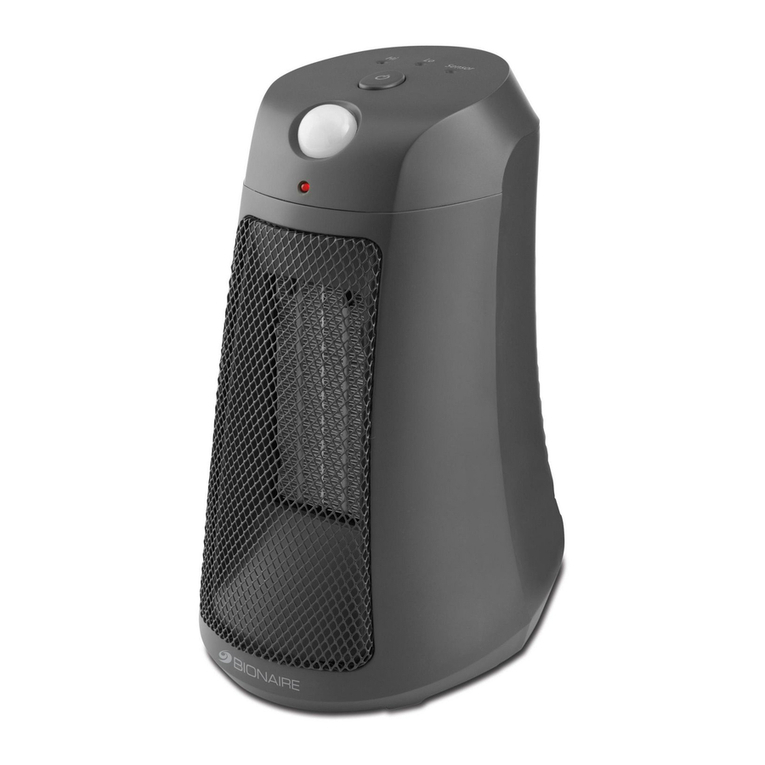BENSON OUH 2 40 User manual

BENS
O
N
Benson equipment must be installed and maintained in accordance with the current OFTEC
Regulations for oil fired products. Due account should also be taken of any obligations arising from
the Health and Safety at Works Act 1974 or relevant codes of practice. In addition the installation must
be carried out in accordance with the current IEE wiring regulations (BS 7671), BS 6896:
Industrial & Commercial) and any other relevant British Standards and Codes of Practice by
a qualified installer. All external wiring MUST comply with the current IEE wiring regulations.
BENSON OUH²
SUSPENDED OIL UNIT HEATER
INSTALLATION AND OPERATING MANUAL
Part No. D301012
INDEX Section
Introduction and Document Index
Installation Requirements ................................................................................. 1
Installation Instructions ................................................................................. 2
Commissioning Instructions ................................................................................. 3
Servicing Instructions ............................................................................................... 4
Spare Parts ............................................................................................... 5
Fault Finding Guide ............................................................................................... 6
Replacing Parts ............................................................................................... 7
User and Operating Instructions .................................................................... 8
WARNINGS

Introduction.
Welcome to the Suspended Oil red Unit Heater Range.
Local regulations may vary in the country of use and it is
the installers responsibility to ensure that such regulations are
satised
All installation, assembly, commissioning and service
procedures must be carried out by suitable qualied
competent persons to the statutory regulations in the
country of use.
When installing, commissioning and servicing is undertaken
on these heaters due care and attention is required to
ensure that working at height regulations are adhered to at the
mounting heights specied.
All Dimensions shown are in mm unless
PLEASE READ this document prior to installation and
use. The safety of this heater is guaranteed only by the
correct usage in accordance with these instructions, therefore
it is recommended that they are retained for future reference.
The manufacturer reserves the right to alter specications without
prior notice.
Any reference made to Laws, Standards, Directives, Codes of Practice or other recommendations governing
the application and installation of heating appliances and which may be referred to in Brochures,
Specications, Quotations, and Installation, Operation and Maintenance manuals is done so for information
and guidance purposes only and should only be considered valid at the time of the publication.
The Manufacturer cannot be held responsible from any matters arising from the revision to or introduction
of new Laws, Standards, Directives, Codes of Practice or other recommendations.
Bio fuel statement.
All our oil red heater products are congured for use on both Class D light distillate fuel oil.
As a result of recent changes made to European legislation regarding the specication of class D heating oil
to allow for the inclusion of 7% FAME (Fatty Acid Methyl Ester) i.e. bio fuel and eective from early 2011, all
oil red air heater products and installations maybe aected.
From April 2011 all our Suspended Oil red Unit Heaters will be tted with Riello burners which are bio fuel
compatible for blends up to 10%.
Please note that the use of bio fuels may give rise to a number of installation issues, to both new and
existing plant which could aect the warranty of the burner. We recommend that you familiarise yourself
with current information from both the burner manufacturer Riello and OFTEC.
IMPORTANT NOTICE TO INSTALLERS
Installers should satisfy themselves that the oil pipework installation is carried out in accordance
with all current legislation, Codes of Practice and recommendations .

Document Index.
1 Installation requirements.
1.1 Compliance notices.
1.2 Certicates of conformity.
1.3 General product information.
1.4 General requirements.
1.5 Delivery and pre-installation checks.
1.6 Warranty.
1.7 Health and Safety.
1.8 Location / Positioning.
1.9 Fuel supply.
1.9.1 Fuel.
1.9.2 Storage tanks.
1.9.3 Single pipe system (gravity fed).
1.9.4 Two pipe system.
1.9.5 Pressurised ring main system.
1.9.6 Pipework and ttings.
1.10 Electrical supply - general.
1.11 Air supply
1.11.1 Heaters installed within the heated space.
1.11.1.1 Natural ventilation openings to the
heated space
1.11.1.2 Mecanical ventilation openings to the
heated space
1.11.2. Heaters Installed within a plant room or
enclosure.
1.11.2.1 Natural ventilation openings to plant
rooms
1.11.2.2 Natural ventilation openings to
enclosures
1.11.2.3 Mech ventilation to a plant room or
enclosure.
1.12 Air distribution system.
1.13 Flue system.
1.14 Dimensions.
1.15 Technical details.
1.15.1 Reference information
2 Installation Instructions
2.1 Packaging/siting
2.2 Heater mounting
2.3 Minimum clearances
2.4 Warm air circulation
2.5 Flue installation
2.6 Oil installation/connection
2.7 Electrical installation/connection
2.8 Heater control installation
Wiring diagrams
3 Commissioning instructions
3.1 Commissioning - pretest
3.2 Commissioning - ignition
3.3 Commissioning - air delivery system.
3.4 Commissioning - hand over
4 Servicing instructions
4.1 Planned servicing.
4.2 Servicing procedure - Major component parts
4.2.1 Flue
4.2.2 Axial fan
4.2.3 Heat exchanger
4.2.4 Electrical supply
4.2.5 Oil supply
4.2.6 Burner
4.2.7 Air delivery system
4.2.8 Report
4.3 Service re-commissioning
5 Spare Parts
6 Fault Finding Guide
7 Replacing Parts
7.1 Burner
7.2 Controller
7.3 Electrode assembly
7.4 Nozzle
7.5 Photocell
7.6 Oil pump
7.7 Contactor
7.8 MCB
7.9 Fan/Limit stat assembly
7.10 Axial fan
8 User and Operating Instructions
8.1 Commissioning and hand over
8.2 Servicing
8.3 Start up procedure
8.4 Stop procedure
8.5 Shut down procedure
8.6 Ventilation only
8.7 Lockout situations

1. Installation Requirements.
1.1 Compliance notices
The Suspended Oil red Unit Heater range detailed
herewith are manufactured within a strictly controlled
quality environment within the parameters of ISO 9001.
These instructions are only valid if the following country code
is on the appliance GB. IE. If this code is not present on the
appliance, it is necessary to refer to the technical instructions
which will provide the necessary information concerning the
modication of then appliance to the conditions of use for the
country.
The Suspended Oil red Unit Heater range have been tested
and assessed for compliance with the following European
Directives.
Machinery Directive: (2006/42/EC)
Low Voltage Directive: (2006/95/EC)
Electromagnetic Compatibility Directive: (2004/108/EC)
Product Liability Directive: (85/374/EEC)
The manufacturer has taken reasonable and practical steps to
ensure that all Suspended Oil red Unit Heaters are safe and
without risk when properly used. These heaters should
therefore only be used in the manner and purpose for which
they were intended, and in accordance with the
recommendations detailed herewith.
The Suspended Oil red Unit Heater range has been designed,
manufactured, assembled, inspected, and tested, with safety
and quality in mind, there are certain basic precautions which
the installer and user should be aware of, and they are
strongly advised to read the appropriate sections of the
information pack accompanying the heater, prior to
installation or use.
The manufacturer supports all new products being supplied
to their customers with a comprehensive information pack;
this clearly denes mandatory instructions for the safe
installation, use, and maintenance, of the appliance(s).
Where proprietary items are incorporated into any Suspended
Oil red Unit Heater, detailed information and instructions are
also provided as part of the information pack.
It is the responsibility of the installer, owner, user, or hirer of a
Suspended Oil red Unit Heater to ensure that they are
familiar with the appropriate information/manuals supplied by
the manufacturer and the safety instructions. In addition,
operators must be suitably trained in the use of the appliance
so as to ensure its continued safe and ecient use.
The manufacturer has a commitment to continuous
improvement and therefore reserve the right to amend or
change the specication of the Suspended Oil red Unit
Heater subject to compliance with the appropriate European,
national and local regulations
Contained within the text of the manual, the words ‘Caution’
and ‘Warning’ are used to highlight certain points.
Caution is used when failure to follow or
implement the instruction(s) can lead to
premature failure or damage to the heater or its
component parts.
Warning is used when failure to heed or
implement the instruction(s) can lead to not only
component damage, but also to a hazardous
situation being created where there is a risk of personal
injury.
The Suspended Oil red Unit Heater range conform to the
following harmonised standards:
BS EN 292 -1
Safety of Machinery - Basic Concepts, General Principles for
Design Basic terminology, methodology BS EN 292-2
BS EN 292 -2
Safety of Machinery - Basic Concepts, General Principles for
Design Technical Principles and Specications
BS EN 60204-1
Safety of Machinery - Electrical Equipment for Machines
Specication for General Requirements
BS EN 60335-1
Safety of Household and Similar Electrical Appliances General
Requirements
BS EN 55014
Limits and methods of measurement of radio disturbance
characteristics of electrical motor-operated and thermal
appliances for household and similar purposes, electrical tools
and similar electric apparatus
BS EN 50165
Electrical Equipment of non-electric heating appliances for
household and similar purposes, safety requirements
1.2 Certicates of conformity
Certicates of conformity are available from the manufacturer,
address details are shown on the back page.

1.3 General product information
The Suspended Oil red Unit Heater range have an output
range from approximately 40.0 kW to 103kW. Each heater
must be connected to its own individual open ue.
Each heater is tted with a forced draught burner which has
been test red and pre-set prior to despatch. The safety
functions of the burner are by way of a fully sequential control
box tted to the burner.
Note
Neither asbestos nor soft soldered joints are used in the
construction or manufacture of the Suspended Oil red Unit
Heater range. The materials selected for use can withstand the
mechanical, chemical, and thermal stresses which they will
be subject to during foreseen normal use when installed in
accordance with the manufacturers recommendations.
1.4 General requirements
Caution
Ensure the fuel supply is in accordance with the manufacture’s
recommendations and is as stated on the appliance data plate.
Installation, commissioning, and servicing must only
be carried out by appropriately qualied and competent
persons.
Warning
Unauthorised modications to the appliance, or departure
from the manufacturers guidance on intended use, or,
installation contrary to the manufacturers recommendations
may constitute a hazard.
Note
To ignore the warning and caution notices, and to ignore the
advice from the manufacturer on installation, commissioning,
servicing, or use, will jeopardise any applicable warranty,
moreover, such a situation could also compromise the safe
and ecient running of the appliance itself, and thereby
constitute a hazard.
The installation of the appliance must meet all the relevant
European, national, and local criteria.
Prior to installation the following points should be considered;
• The position of the heater for the optimum ecient
distribution and circulation of warm air.
• The position of the heater relative to the route of the
ue
• The position of the heater relative to the supply of fuel
• The position of the heater relative to the electrical
services, and if appropriate, any additional controls.
• The position of the heater relative to the supply of
fresh air
• The height if applicable at which the heater is to
be mounted and potential stratication /circulation
problems.
• The position of the heater relative to service and
maintenance requirements
Caution
The heater must not be installed within an area where the
conditions are unsuitable, e.g. where the atmosphere is highly
corrosive, has a high degree of salinity, or where high wind
velocities may aect burner operation. Suitable protection
should be provided for the appliance when it is located in a
position where it may be susceptible to external mechanical
damage from; for example, fork lift trucks, overhead cranes
etc.
1.5 Delivery and pre-installation checks.
The heater is supplied wrapped in heavy duty protective
polythene. On receipt of the heater, the following checks
should be carried out;
• The model is as per order.
• That it is undamaged.
• That it is suitable for the fuel supply.
• That it is suitable for the electrical supply
If any of these points are not satised then contact should be
made with the suppliers sales oce as soon as possible by
telephoning the number shown on the rear page. In the case
of claims for damage, this must be signed for as damaged
and reported in writing within 24 hours of delivery, in order to
comply with insurance criteria.
1.6 Warranty
The heater is supplied with a 1 year parts and labour warranty
and a further year on all parts excluding consumable’s.
In addition to this there is a 10 year time related warranty on
the combustion chamber.
The warranty commences from the date of dispatch from the
manufacturer, and is subject to the terms detailed within the
Manufactures ‘conditions of business’.
Note (i)
The warranty may be invalidated if -
• The installation is not in accordance with the general
requirements of this manual.
• The ue arrangement and air supply for the heater are

not in accordance with the manufacturers
recommendations, codes of practice, or similar standards.
• Air ow through the heater is not in accordance with
the manufacturers technical specications.
• Internal wiring on the heater has been tampered with
or unauthorised service or repairs undertaken.
• The main electrical supply input to the heater has
been interrupted during the heating mode.
• The heater has been subject to and aected by the
ingress of water in any form.
• The heater is not operated at the rating(s) laid down in
the manufacturers technical specications.
• The heater has not been operated or used within the
normal scope of its intended application.
• The manufacturer’s recommended minimum service
requirements have not been complied with
Note (ii)
All warranty claims must contain the following info to enable
processing to take place
• Heater model
• Heater serial number
• Order reference/date of order, together with full
installation details (name and address)
• Details or symptoms of fault
• Installers name and address.
Faulty parts must be returned to the supplier, the address of
which is provided at the rear of this manual.
Any such parts will undergo inspection to verify the claim.
Replacement parts supplied prior to this may be charged, and
a credit supplied upon subsequent validation of the warranty
claim.
Consumable items are specically not included within the
scope of the warranty.
Note (iii)
Notication is required immediately a fault is suspected.
The manufacturer will not accept responsibility for any
additional damage that has been caused, expense incurred, or
consequential loss resulting from any failure of the heater(s).
1.7 Health and Safety
The Suspended Oil red Unit Heater range must be
installed in accordance with the current OFTEC regulations for
oil red products Due account should also be taken of any
obligations arising from the Health and Safety at Works Act
1974 or relevant codes of practice. In addition the installation
must be carried out in accordance with the current IEE wiring
regulations (BS 7671), BS 6896: (Industrial & Commercial) and
any other relevant British Standards and Codes of Practice by
a qualied installer. Isolate all electrical supplies to the heater
& controller before proceeding.
For your own safety we recommend the use of safety boots
and leather faced gloves when handling sharp or heavy items.
The use of protective eye wear is also recommended.
Caution
Before using this appliance:
• Check that the voltage indicated on the type plate
corresponds to the mains supply voltage.
• Ensure that the heater has been securely fastened in
its nal mountain position.
UNDER NO CIRCUMSTANCES should any item be placed
on or above any part of the heater, whether the heater is
being used or not.
WARNING: This appliance must be earthed.
1.8 Location / Positioning
Warning
All of the basic criteria must be satised prior to commencing
installation and commissioning, additionally, the Suspended
Oil red Unit Heater must be positioned and installed so as to
comply with all the relevant standards and guide lines (see
section 1.1), as well as meeting national and local re
regulations and insurance criteria, especially if it is proposed
that the heater is to be installed within a special risk area (e.g.
proximity to where petrol engined vehicles are stored or
parked, where cellulose spraying takes place, where
woodworking machinery is operated, etc,).
Indirect heaters must not be located in hazardous areas,
however, it is permissible for the heater to supply air to such
areas.
The heater must not be installed within an environment
where there is a high concentration of chlorides, uorides,
salts, or other aggressive or volatile chemicals/compounds.
Nor should the heater be positioned where the burner could
be adversely aected by high winds or draughts.
The location chosen for the heater must allow for the tting of
an eective ue system.
The location must also allow for adequate clearance for the air
supply, return air circulation, oil supply and electrical supply,
whilst also providing good and safe working access.
Suspended free blowing Unit Heaters are at their most

eective when located as close to the working area as
possible. However care should be exercised to avoid directing
the discharged air directly onto the occupants of the area to
be heated.
On exposed walls heaters should be positioned so as to
discharge towards, or along the length of the exposed wall. In
areas where it is proposed that more than one heater is to be
installed, a general scheme of circulation should be drawn up
and maintained, thereby oering the best heat distribution.
Air pressure within the area heated and the outside air
pressure must remain the same, factors inuencing this would
be the presence of extraction systems, ventilation systems,
and various types of process plant. OUHA 60-100 models can
be installed to allow the fans to work in opposite directions.
This enables the heater to be installed centrally in the area to
be heated and allows warm air to be discharged to both the
front and rear of the heater.
The heater must be installed on a at and level surface made
from non-combustible material, which is suciently robust
to withstand the weight of the heater and any ancillary
equipment. Any combustible material adjacent to the heater
or ue system must be so placed or shielded so that its surface
temperature does not exceed 65°C.
In areas where it is proposed that more than one heater is to
be installed, a general scheme of circulation should be drawn
up and maintained, thereby oering the best heat distribution
All Suspended Oil red Unit Heaters are tted with a pressure
relief facility, this is incorporated into the design of the ue gas
exit duct.
Care should therefore be taken in siting service connections
and controls well away from the pressure relief vent.
Warning
Under no circumstances must the pressure relief be
restricted, blocked, or have the free exit of exhaust gas
impaired or re-directed.
1.9 Fuel supply - general
The Suspended Oil red Unit Heater range are all
manufactured and pre-set for use with either 28 second or
35 second gas oil delivered to the burner via a suitable piped
system from the oil storage tank.
Galvanised or plastic pipe work and ttings must
not be used. (see BS 5410 Part 1 1997)
The constraints of the application will, to a large extent,
determine whether it is preferable to use a single pipe gravity
feed system, or whether the two pipe pumped system is more
appropriate.
Where more than one appliance is to share a common supply
it will be necessary to use a pressurised ring main system.
All pipe work must be constructed and installed so that it does
not permit the ingress of air.
The construction, size, and position of the oil storage tank
must take account of the current regulations, as well as suiting
the requirements of the installation.
Please refer to pages 9 and 10 for additional information.
Caution
On pumped systems always check that the pump is correctly
set up prior to running, and always ensure that valves are
open allowing a free ow of oil through the system.
1.9.1 Fuel
In order to promote trouble free operating it is necessary that
the oil within the storage tank and oil line does not fall below
the cold lter plugging point (cfpp), in this country and with
class D fuel (also referred to as gas oil). The critical
temperature is -4°C for this summer grade.
The cfpp critical temperature for the winter grade is -12°C.
If summer grade fuel is stored for winter use in areas prone
to severe frosts and low temperatures it will be necessary to
insulate or even heat the supply tank and pipe work.
Note
The fuel supplier should be contacted prior to installation so
that any requirements concerning delivery, transport, storage
and use can be addressed before work commences.
Warning
The inlet pump pressure must not exceed a maximum of 0.4
bar, this is because beyond this point gas is liberated from the
oil.
1.9.2 Storage tank
An externally painted steel storage tank to BS 799 part 5 1987
or a medium density polyethylene oil tank OFTEC certied
to OFS T-100 may be used. Local, national, European and re
regulations must also be complied with and must include:
• A fuel level gauge (not made from glass) a vent pipe
with a diameter greater than that of the ller and
featuring a weatherproof termination.
• A sludge valve.

• An outlet valve situated at the opposite end of the
tank to the sludge valve.
• A ller pipe connection situated at the opposite end
to the outlet valve.
The size of the storage tank must take account of the
estimated consumption and any quantity price breaks oered
by the oil supplier.
It is preferable to install the tank outside, however, if this
is not practicable and the tank has to be installed indoors
advice must be sought about its siting, especially so far as re
regulations are concerned.
If a separate re resistant chamber cannot be provided for
indoor installations, a catchment pit with a capacity 10%
greater than that of the storage tank must be provided
Storage tanks can if necessary be sited on a roof, but this is
subject to special regulations as well as local authority
approval and compliance with re regulations, reference to
BS 5410 part 2 1978 & part 1 1997 is strongly suggested.
It is advisable to leave the tank unpainted on the inside, but
to paint the outside with a proprietary grade of anti-corrosive
paint.
Warning
A galvanised or open topped tank is strictly not allowed.
Warning
All oil storage tanks require a bund
The Control of Pollution Regulation (Oil Storage) 2001 should
be consulted prior to installation.
1.9.3 Single pipe system (gravity feed)
For installations where the oil tank is 200mm or more above
the level of the fuel pump the principle of gravity feed may be
used.
The draw o point for the supply to the burner must not be
positioned any lower than 100mm above the bottom of the
tank.
Where a return valve is tted this must be tamper proof to
prevent inadvertent operation.
Caution
If the valve is closed when the pump is running the oil
pressure can be increased suciently so as to cause damage
to the seals within the pump.
The return oil should preferably be discharged through an
elbow onto a tank plate situated within the tank, this should
be positioned so as not to introduce air or air bubbles into the
draw o pipe.
1.9.4 Two pipe system
This is used where the oil storage tank is lower than the pump.
Access for the fuel feed to the burner should be via a suitable
tapping made in the top of the tank, and the fuel feed pipe
should extend to not less than 100mm above the bottom of
the tank.
A none return valve with a metal to metal seat should be
tted, especially if the return pipe work is terminated at a
level above the draw o tube. The non- return valve must be
removable for service and maintenance purposes, and the
return pipe from the pump must therefore be extended down
into the tank to the same level as the suction pipe.
The presence of a tamper proof isolating valve tted within
the return pipe is only required if there is a risk that oil will
siphon out of the tank if the return pipe is disconnected at the
pump during maintenance or servicing and if the none return
valve has been omitted.
Caution
The Deareator must be tted the burner side of the inlet fuel
lter
Maximum lift should not exceed 3.5 metres, and the vacuum
should not exceed 0.4 bar.
Each heater must have a separate fuel supply.
Note
It is strongly recommended that the separate manual
concerning the operational details of the burner supplied with
the heater as part of the information package is studied prior
to installation.
1.9.5 Pressurised ring main system
This system is used to supply a number of units from a
common storage tank.
A booster pump is used to provide the pressure to push the oil
around the ring main and back to the tank.
Pressure reducing valves should be tted on the delivery pipe
to each heater to ensure that the pressure at the burner pump
is less than 6 psi.

Caution
The internal by-pass plug must be removed from the burner
pump when used in a pressurised ring main application.
1.9.6 Pipe work and ttings
Warning
Galvanised or plastic pipe work and ttings must not be used.
(see BS 5410 Part 1 1997)
Caution
All joints must be sealed properly, if necessary using PTFE tape
or other approved sealing media.
Caution
The pipe work must be eectively sealed so as to prevent the
ingress of air.
Note:
It is advisable to check all pipe work prior to installation to
ensure that there is no loose debris or scale present.
Black iron pipes can be hammered to assist in the removal of
these contaminants.
Note:
The oil feed to each heater must be tted with a re check
valve and isolating valve.
Caution
The re check valve must be operated by way of a fusible link
positioned so that it is above the burner.
Note:
Any waste oil or sludge must be disposed of correctly.
Warning
Never dispose of it by dumping or tipping it down drains or
into watercourses where ground water can become polluted
and environmental damage caused.
1.10 Electrical supply
Wiring external to the the Suspended Oil red Unit Heater
must be installed in accordance with any local, national, and
European regulations, as well as meeting the appropriate
requirements of IEE regulations.
Caution
The means of connection to the main electrical supply must
allow for complete electrical isolation of the heater,
furthermore, in the case of a unit wired for a three phase
supply, the supply should only be used to serve the heater
itself and no other plant or equipment. The position of the
isolation switch must be such that it is adjacent to the heater
and easily accessible at all times. In addition, the isolator itself
must have a contact separation of not less than 3mm.(as per
BS5991 clause 20.2).
The Control fuse ratings are detailed on the appliance data
plate.
Warning
Ensure that the electric and oil supplies are turned o before
any electrical work is carried out on the heater.
Caution
Ensure that wiring cannot make contact with any surfaces
liable to be subject to high temperatures or where the
insulation of the wiring could be impaired as a result of such
contact.
Warning
All connections must be checked to ensure that they are
secure, and free from corrosion.
Warning
Terminals and connections should also be checked to ensure
that no stray strands are bridging terminals.
Caution
Final connections for any additional external controls must be
completed on site, and must be carried out according to IEE
regulations.
Separate user information is provided for the time control unit
and the burner, and forms part of the product information
pack which accompanies every heater when despatched.
Warning
All heaters are supplied fused and pre-wired, all must be
earthed.
Caution
The main electrical supply must not be switched o or
disconnected as a method for stopping the heater, the
exception to this is in an emergency, or during servicing, when
the heat exchanger has been allowed to cool suciently to
prevent any damage from occurring. Claims for damage will
not be considered if they have resulted from incorrect wiring
or the incorrect use of the heater.
Warning
Always ensure that the appropriate personal protective
equipment is used.

Pressurised oil feed system
Burner oil pump details 205 - 375 suction feed
Burner oil pump details for heater models 30 - 180 oil lines
L metres
H(m) 8mm I.D 10mm I.D
0.0 35.0 100.0
1.0 30.0 100.0
1.0 25.0 100.0
1.5 20.0 90.0
2.0 15.0 70.0
3.0 8.0 30.0
3.5 6.0 20.0

1.11 Air supply
Consideration must be given to the provision of air for the
purposes of combustion and ventilation of the heated space,
plant room or enclosure where heaters are to be installed.
It is a requirement that the area where the air heater is located
must have a permanent air vent of negligible resistance direct
to the outside air.
Such air vents must be positioned so as not to become
blocked or ooded, nor should they be placed so as to
introduce undesirable matter (e.g. ammable, volatile, or
aggressive chemicals/compounds or potentially hazardous or
harmful substances) either direct from the outside, or through
their proximity to an adjacent extraction system.
Note:
It is strongly recommended that BS6230 is referred to for
further information concerning ventilation requirements
Where mechanical ventilation is used it is a requirement that
the inlet is of the mechanical type, and the outlet is either
mechanical or natural.
1.11.1 Heaters installed within the heated space.
Where heaters are installed within the space to be heated (i.e.
not a plant room or enclosure) then:
Combustion air or heater related ventilation air will not be
required if -
• The design air change rate of the heated space is 0.5
air changes per hour or greater
or
• The design air change rate may be satised by natural
inltration or by mechanical ventilation
Combustion and General ventilation will be required if -
• The design air change rate of the heated space is less
than 0.5 air changes per hour
or
• Where the heated space has an air change rate of less
than 0.5 air changes per hour then it will be necessary to
provide either natural ventilation openings to the heated
space (section 1.11.1.1. refers) or the mechanical ventilation
of the heated space (section 1.11.1.2. refers)
1.11.1.1 Natural Ventilation Openings to the Heated Space.
If the heated space design air change rate is less than 0.5
air changes per hour then provision for low level natural
ventilation openings will only be necessary.
The minimum free area of the low level natural ventilation
opening shall be:
• 2cm2 for each kW of rated heat input
The low level natural ventilation opening should be situated
on an external wall and be within 1000 mm of oor level.
The following table provides specic data for each heater
model as -
Minimum Free Area of ventilation
opening
Model High Level cm² Low Level cm²
40 None 88
60 None 128
70 None 166
90 None 192
100 None 230
1.11.1.2 Mechanical Ventilation to the Heated Space.
In the event that the heated space has a design air change of
less than 0.5 air changes per hour and that installer prefers to
mechanically ventilate the heated space rather than provide
ventilation openings then:-
• The heated space needs to be mechanically ventilated
so that the design air change is 0.5 air changes or greater.
• It is a requirement that the mechanical ventilation shall
be of the ‘input’ type with either natural or mechanical
extraction.
• Systems of mechanical extraction with a natural inlet
shall not be used.
It is necessary to provide an automatic means to safely inhibit
heater(s) operation should mechanical air supply fail for any
reason.
1.11.2. Heaters Installed within a Plant Room or Enclosure.
A plant room means a room housing the heater plant and
probably other items of building service plant and would
generally have generous space for maintenance.
An enclosure is where the heater is installed within a
compartment or conned area where space is limited.
Whereheatersareinstalledwithinaplantroomorenclosurethen
provision for both combustion air and air for general ventilation
will be required by means of high and low level ventilation

openings (sections 1.11.2.1 refers to plant room applications
and sections 1.11.2.2 refers to enclosure applications).
Alternatively the plant room or enclosure may be
mechanically ventilated (section 1.11.2.3 refers).
1.11.2.1 Natural Ventilation Openings to Plant Rooms
For plant room applications the minimum free area of
ventilation opening shall be:
• At high level 2 cm2 for each kW of rated heat
input.
• At low level 4 cm2 for each kW of rated heat
input.
The high level ventilation opening should be sited on an
external wall and positioned as high as is practical and always
within the top 15% of the wall height.
The low level natural ventilation opening should be situated
on an external wall and be within 1000 mm of oor level.
The table below provides specic data for each heater model
as -
Minimum Free Area of ventilation
opening
Model High Level cm² Low Level cm²
40 88 176
60 128 258
70 166 332
90 192 384
100 230 460
1.11.2.2 Natural Ventilation Openings to Enclosures
For enclosure applications the minimum free area of
ventilation opening shall be:
• At high level 5 cm2 for each kW of rated heat
input.
• At low level 10 cm2 for each kW of rated heat
input.
The high level ventilation opening should be sited on an
external wall and positioned as high as is practical and always
within the top 15% of the wall height
The low level natural ventilation opening should be situated
on an external wall and be within 1000 mm of oor level.
The table in the next column provides specic data for each
heater model as:-
Minimum Free Area of ventilation
opening
Model High Level cm² Low Level cm²
40 220 440
60 320 640
70 415 830
90 480 960
100 575 1150
1.11.2.3 Mechanical Ventilation to a Plant Room or
Enclosure.
In the event that the installer prefers to mechanically ventilate
the plant room or enclosure rather than provide ventilation
openings then:-
• The plant room or enclosure needs to be
mechanically ventilated at the rate of 4.14 m3/h of
fresh air per kW or rated heat input.
• It is a requirement that the mechanical ventilation
shall be of the ’input’ type with either natural or
mechanical extraction. Where mechanical extraction is
selected then the extraction rate should be 5%-10% less
than the input rate.
• Systems of mechanical extraction with a natural inlet
shall not be used
It is necessary to provide an automatic means to safely inhibit
heater(s) operation should mechanical air supply fail for any
reason
The table to follow provides specic data for each heater
model as -
Mechanical Ventilation Rate
for Plant Room or Enclosure
Model M³/h
40 182
60 265
70 344
90 397
100 476

1.12 Air distribution system
The air heater should be positioned to enable maximum
circulation of discharged warm air within the area to be
heated, whilst taking account of personnel within the area,
sources of cold air ingress, and obstructions.
Caution
Ensure louvres are adjusted outwards and ensure blades are
not resonating
The air temperature rise on passing the heat exchanger is
typically around 34°C
A full and unobstructed return air path to the air heater must
be provided (see 1.11 Air Supply).
Where the heater is positioned to deliver blown air through an
opening in a wall, return air intakes should be located so that
they cannot become blocked. Similarly these intakes must
be positioned so as not to draw in odours, fumes, hazardous
vapours or particles.
1.13 Flue system.
Warning
It is essential that the products of combustion are ued to
the outside of the building. Each heater must have its own
separate ue, with a ue diameter of not less than is detailed
in section 1.15 within this manual.
The minimum vertical length of ue must not be less than
1m. The ue should rise vertically, and the number of bends
should be kept to a minimum.
Note:
It is strongly advised that BS 5854; 1980, and BS 5440; parts 1
and 2, are used as consultative documents when considering
ue requirements.
Care should be taken to ensure that the ue terminal is not
situated in a high-pressure area, the proximity of buildings
and other obstacles which will inuence this must be taken
into account, preferably at the design stage.
Provision must be made for the disconnection of the ue for
inspection and service requirements, and it is strongly advised
that where bends are tted inspection covers are included.
Flue should be supported at intervals not exceeding 1.8 mtrs
The materials from which the ue is constructed must be
non-combustible, resistant to internal and external corrosion,
and be capable of withstanding the stresses and loadings
associated with normal use.
When designing the ue system the prevention of the
formation and entrapment of condensation must be a key
consideration.
Twin wall or insulated systems are recommended, as they tend
to inhibit the formation of condensates.
Where condensation is unavoidable traps should be included
to encourage the condensates to ow freely to a point from
which they may be released, preferably into a gully.
The condensate pipe from the ue to the disposal point must
be made from corrosion resistant pipe of not less than the
internal diameter of the drain pipe.
If the ue passes through a wall, ceiling, or roof made from
combustible material then it has to be sleeved so as to provide
a minimum of a 25mm void between the exterior of the ue
and the internal wall of the sleeve. The maximum permitted
temperature of any adjacent combustible material is 65°C.
The position of the ue and its terminal should be such that it
does not impair the combustion process.
It should terminate in an exposed position so as to allow the
escape and dissipation of ue gases without risk of their
re-entering the property through windows, ventilation ports,
etc. The ue should extend to at least 1m above the height of
any object within 3.5m of the terminal.
Flue terminals should be tted on all ues, the terminal must
be of the approved type, and have outlet grilles on all sides
giving a total free area of at least double that of the ue.
Caution
It is imperative that the ue should be properly sealed where
it passes through the roof, this can best be achieved by using
the approved method of roof ashing plate and cravat.
Note:
It should be noted that claims made under warranty and at-
tributed to the ingress of water may not be considered
especially if an approved method of sealing has not been
used, or if the design of the ue has not made provision for
possible condensation problems.

1.14 Dimensions
Model A B C D E F G H J K L M N P
40 780 1050 895 125 755 17 640 20 36 182.5 340 380 212 139
60 780 1475 895 150 1177 17 640 20 36 170 340 380 212 139
70 780 1475 895 150 1177 17 640 20 36 170 340 380 212 139
90 980 1750 1055 175 1365 17 770 20 36 231 405 810 300 219
100 980 1750 1055 175 1365 17 770 20 36 231 405 810 300 219

Model A B C D E F G H J K L M N P R S
40 780 1050 1240 125 755 17 640 20 36 182.5 340 380 212 139 729 730
60 780 1475 1175 150 1177 17 640 20 36 170 340 380 212 139 1151 730
70 780 1475 1175 150 1177 17 640 20 36 170 340 380 212 139 1151 730
90 980 1750 1376 175 1365 17 770 20 36 231 405 810 300 219 1339 930
100 980 1750 1376 175 1365 17 770 20 36 231 405 810 300 219 1339 930

1.15 Technical Details
Model 40 60 70 90 100
Heat Output (max) kW/hr
Btu/hr 39.78
135,725 58.61
200,000 71.88
245,240 87.92
300,000 102.50
350,000
Heat Input (Nett) kW/hr
Btu/hr 44.60
152,175 64.25
219,220 82.73
282,250 96.04
327,690 114.8
391,640
Nett Eciency % 89.23 91.22 89.10 91.55 89.3
Burner Type Riello G5 G10 G10 G20 G20
Oil Connection BSP 3/8 3/8 3/8 3/8 3/8
Fuel Consumption 35s Imp gall/hr
litre/hr 1.0
4.5 1.43
6.5 1.76
8.0 2.13
9.7 2.55
11.57
Burner Pressure 35s Psi
Bar 190
13.1 160
11.0 160
11.0 160
11.0 180
12.4
Nozzle Size 35s 0.85 - 60°S 1.35 - 45°S 1.75 - 60°S 2.0 - 60°S 2.25 - 45°S
Fuel Consumption 28s Imp gall/hr
litre/hr 0.98
4.45 1.6
7.2 2.0
9.0 2.3
10.4 2.5
11.34
Burner Pressure 28s Psi
Bar 150
10.5 140
9.5 130
8.8 140
9.5 135
9.2
Nozzle Size 28s 1.0 - 60°S 1.5 - 60°S 2.0 - 60°S 2.25 - 60°S 2.75 - 60°S
Head Setting 0 ue resistance Number 6 4 5 2 1.5
Air Setting 0 ue resistance Number 5.5 3 4.5 2 2.8
Air Flow (std) m³/sec
ft³/min 1.52
3220 2.6
5500 2.6
5500 2.77
5800 2.77
5800
Outlet Pressure OUHC Pascals
Ins WG 150
0.6 180
0.72 150
0.6 180
0.72 180
0.72
Air Throw (approx) mtrs
ft 23
75.5 37
121 37
121 39
128 39
128
Temp Rise Through Heater °C
°F 32
90 34
93 35
95 33
91 35
95
Combustion Chamber mbar 0.14 0.14 0.14 0.14 0.14
Sound Level dba 65 68 69 71 71
Flue Resistance Min mbar
Max mbar -0.1
+0.2 -0.1
+0.2 -0.1
+0.2 -0.1
+0.2 -0.1
+0.2
Flue Diameter mm 125 150 150 175 175
Electrical Supply V/Hz/P 230/1/50 230/1/50 230/1/50 230/1/50 230/1/50
Rated Input OUHA kW 0.55 0.9 0.9 1.1 1.1
Fused Isolator Size OUHA Amps 6 6 6 10 10
Running Current OUHA Amps 1.5 2.5 2.5 4.0 4.0
Rated Input OUHC kW 1.1 1.1 1.1 2.2 2.2
Fused Isolator Size OUHC Amps 10 16 16 20 20
Running Current OUHC Amps 8 11 11 15 15
Electrical protection IP 20 20 20 20 20
Weight OUHA kg 116 177 177 240 240
Weight OUHC kg 138 212 212 280 280

1.15.1 Reference Information
Doc/Ref Title/Subject
BS 5410-1 & -2 Code of Practice for Oil ring
BS EN 292-1 &-2 Safety of Machinery
BS EN 60204-1 Safety of Machinery - Electrical
BS EN 60335-1 Safety of Electrical Appliances
BS EN 55014 Electromagnetic Compatibility
BS EN 50165 Safety of Electrical Equipment
BS 5854 Code of Practice - Flues/Flue Structures
BS 799-5 Oil Burning Equipment - oil tanks
OFTEC OFS T-10 Polyethylene oil storage tanks
BS 715 Metal Flue Pipes and Fittings
BS 5440-1 Specication/Installation of Flues
BS 5440-2 Ventilation Requirements Gas Appliances
BS779 Oil Burning Equipment - Burners
ISO 228/1 Pipe Threads Seals and Couplings
See also BS 2779 and BS 5380)

2. Installation.
It is strongly advised that the installer reads Section 1 of
this manual prior to starting any installation work. It is a
requirement that only qualied and competent personnel
undertake installation, commissioning, and servicing.
Warning
Always ensure that the appropriate personal protective
equipment is used.
2.1 Packaging/siting
The heater will usually be supplied wrapped in heavy gauge
polythene, non assembled parts will be supplied separately.
Prior to installation, the assembly of the heater should be
completed, it is advisable that this is undertaken in the area
where the heater is scheduled to be sited.
Caution
The Heater must be installed within the mounting heights
indicated below in metres.
The following clearances in mm must be observed *when
suspended:
Model Min Max
40 2.0 2.7
60 2.4 3.0
70 2.4 3.5
90 2.5 3.5
100 2.4 3.5
2.2 Heater Mounting
The heater and ue must be adequately supported by one of
the following methods;
• Suspension by steel drop rods or straps from the M10
xing points located on top of the heater. These must be
of sucient strength to safely carry the weight of the unit
and ancillary equipment. The straps may only drop
vertically to eyebolts, if used; I.E. They must not be joined
to the eyebolt at an angle to the vertical, and eyebolts, if
used, should be of an approved type.
• OUH heaters can be mounted on specically designed
cantilever wall or vertical stanchion brackets which locate
directly to the four M10 xings on the heater casing.
Alternatively OUHA or OUHC units can be mounted on
cantilever type wall brackets however consideration must
be given to ensure that the bracket is large enough to
support the heater whilst providing the necessary
clearances.
In either case the installer should ensure that the wall wall
xings or other support medium is capable of supporting
the weight
• On a level non-combustible surface capable of
adequately supporting the weight of the unit and
ancillary equipment .
2.3 Minimum Clearances
The following minimum clearances (in millimeters) are
recommended when installing the heater.
Model 40 60 70 90 100
Above 300
Below* 300
RHS 680 810
LHS 250
Rear OUHA 400 560
Rear OUHC 200
2.4 Warm Air Circulation
The air heater should be positioned to enable maximum
circulation of discharged warm air within the area to be
heated, whilst taking account of personnel within the area,
sources of cold air ingress, and obstructions.
Caution
Ensure louvres are adjusted outwards and ensure blades are
not resonating
The air temperature rise on passing the heat exchanger is
typically around 34°C
A full and unobstructed return air path to the air heater must
be provided (see 1.11 Air Supply).
Where the heater is positioned to deliver blown air through an
opening in a wall, return air intakes should be located so that
they cannot become blocked. Similarly these intakes must
be positioned so as not to draw in odours, fumes, hazardous
vapours or particles.

2.5 Flue Installation
An integral ue spigot is tted to all the Suspended Oil red
Unit Heater thereby allowing the ue to connect directly to
the heater.
The design of the ue must ensure that it can be disconnected
to allow for cleaning and servicing, furthermore, all of the ue
section joint sockets must face upwards, and the seal between
the sections achieved through mechanical joints or through
the use of approved caulking string and grout.
Caution
It is strongly advised that BS 5854 and BS 5440 parts 1 and 2
are referred to.
Where condensation is likely to be a problem provision should
be made preferably at the design stage (see section 1.13)
2.6 Oil Installation/connection
The oil tank must be positioned so that there is a fall of 7.5mm
(+/- 2.5mm) for every 30mm away from the outlet and towards
the sludge/drain valve, which must be sited at the lowest
point in the tank. If the tank is positioned on supports then
there must be an adequate protective layer between tank and
support to prevent damage or deterioration through
corrosion.
It is strongly suggested that reference is made to BS 5410 ; part
2 ; 1978.
It is also suggested that the installer is familiar with the detail
and requirements contained within sections 1.9 of this manual
prior to commencing installation.
Warning
Prolonged exposure and contact with Gas Oil can result in the
natural oils being removed from the skin, sensitisation can
result in dermatitis.
Always ensure that the appropriate personal protective
equipment is used.
2.7 Electrical Installation/connection
The Suspended Oil red Unit Heater range is only available in
230V 50Hz 1PH.
It is recommended that reference is made to the wiring
diagrams contained within section 2.9 of this manual prior to
installation or connection to the supply. The electrical supply
must be as specied and suitable for the heater, and must
be run within conduit to a point adjacent to the heater, and
be terminated to provide an isolation point that will prevent
remote or inadvertent activation.
Cables, conduit, and ttings that are used to make the
connection between the isolator and the heater must conform
to the appropriate IEE regulations.
All heaters are supplied fused and pre-wired, all must be
earthed.
Final connections for any additional external controls must be
completed on site, and must be carried out according to IEE
regulations.
Separate user information is provided for the time control unit
and the burner, and forms part of the product information
pack which accompanies every heater when despatched.
Warning
Always isolate from mains electrical supply before
commencing work on the heater.
Warning
Always ensure that the appropriate personal protective
equipment is used.
2.8 Heater Control Installation
Warning
Isolate heater from mains before undertaking any electrical
work.
Unless specied all unit Heaters are manufactured and
supplied with a remote controllers to be wired back to the
heater.
Refer to Controller instruction manual for full installation
details.
See following section for individual wiring diagrams.

Wiring Diagram 33-65-245
Models OUHA/OUHC40 ON/OFF Riello Oil Fried Burner
This manual suits for next models
4
Table of contents
Other BENSON Heater manuals
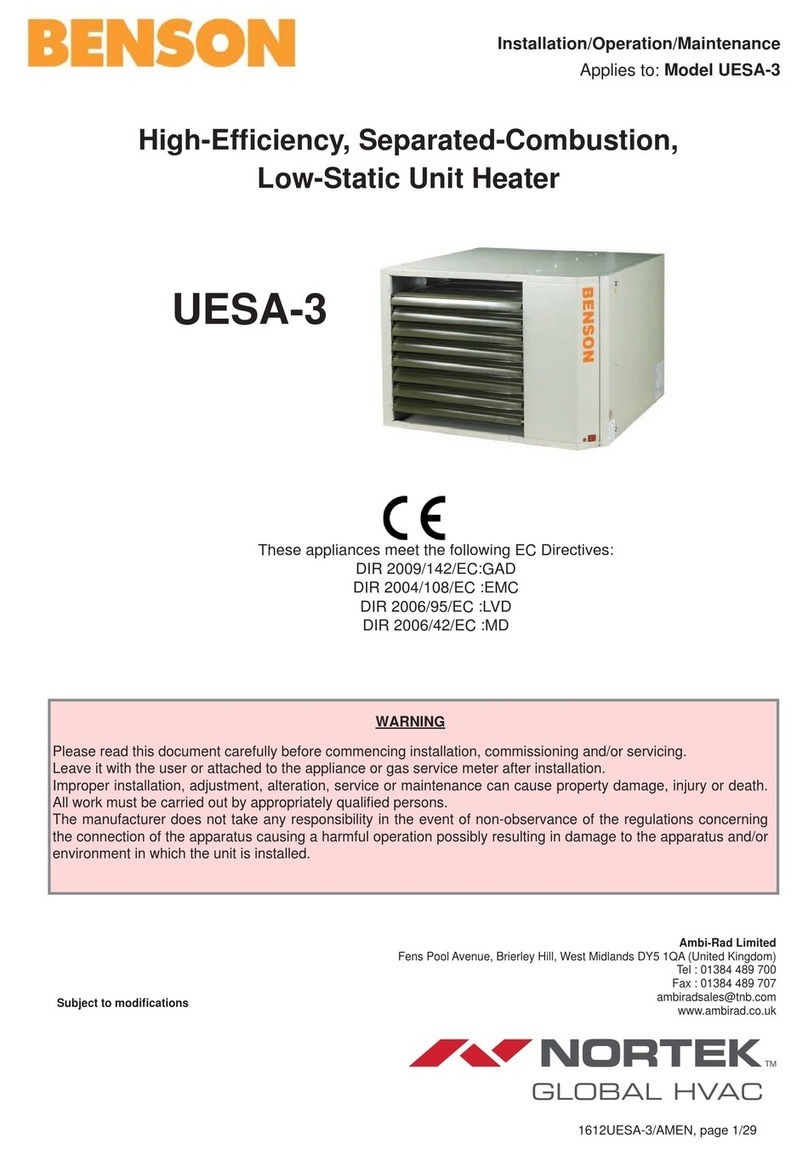
BENSON
BENSON NORTEK UESA-3 Owner's manual

BENSON
BENSON OUHA 100 Guide

BENSON
BENSON AH150 Guide
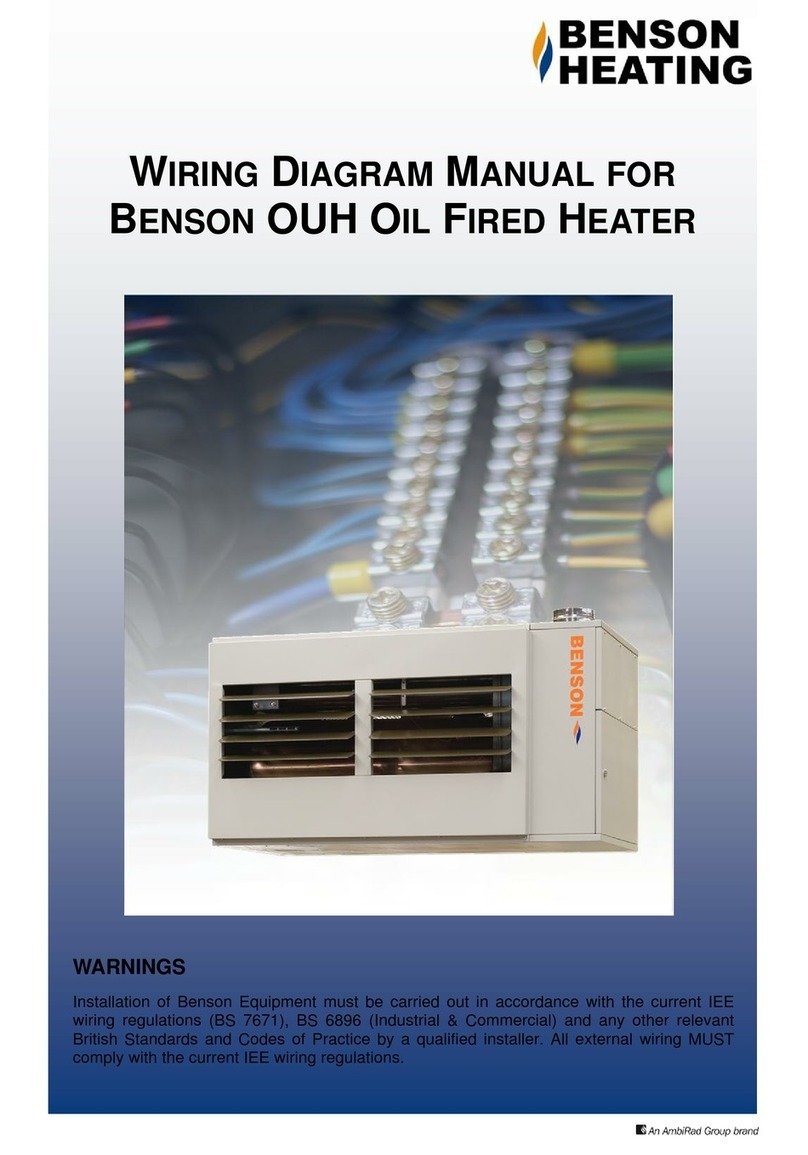
BENSON
BENSON OUH Series Quick start guide
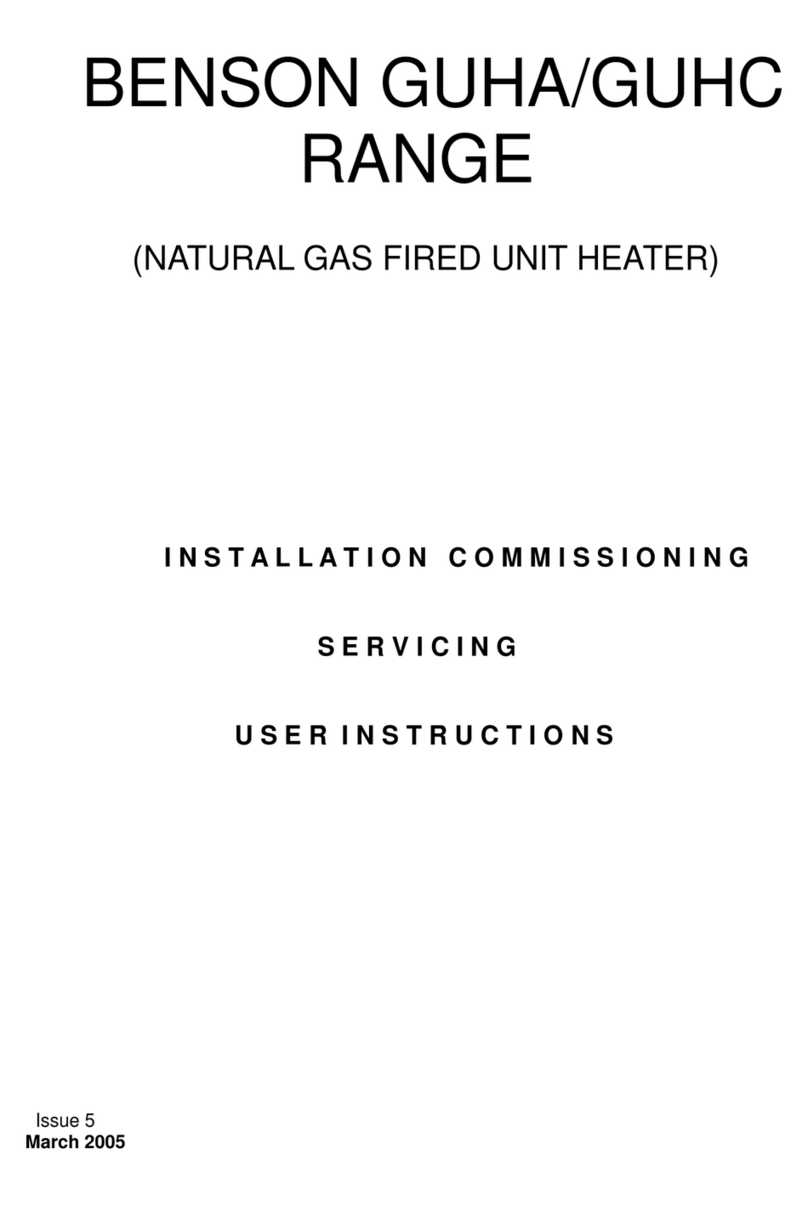
BENSON
BENSON GUHA User manual

BENSON
BENSON RH06 User manual

BENSON
BENSON ULTRA 035(EC) Manual
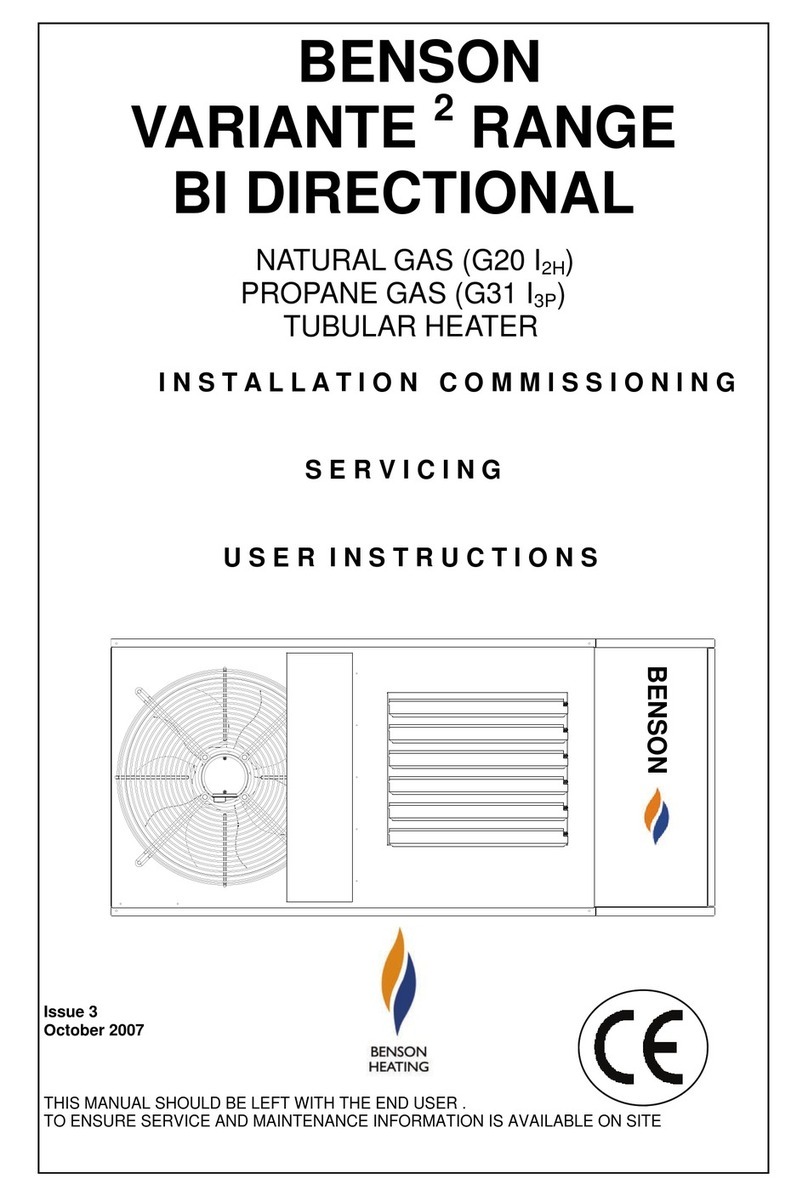
BENSON
BENSON VRBD 250 User manual
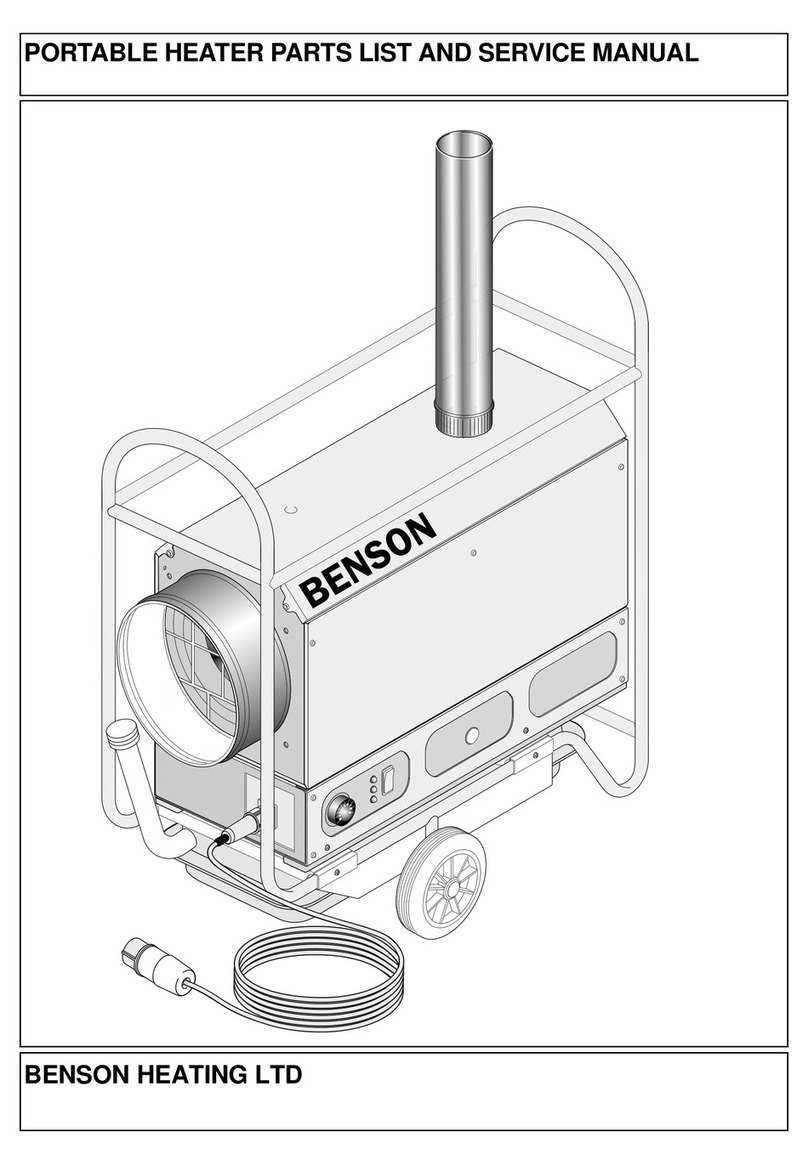
BENSON
BENSON LD7 1LP Troubleshooting guide
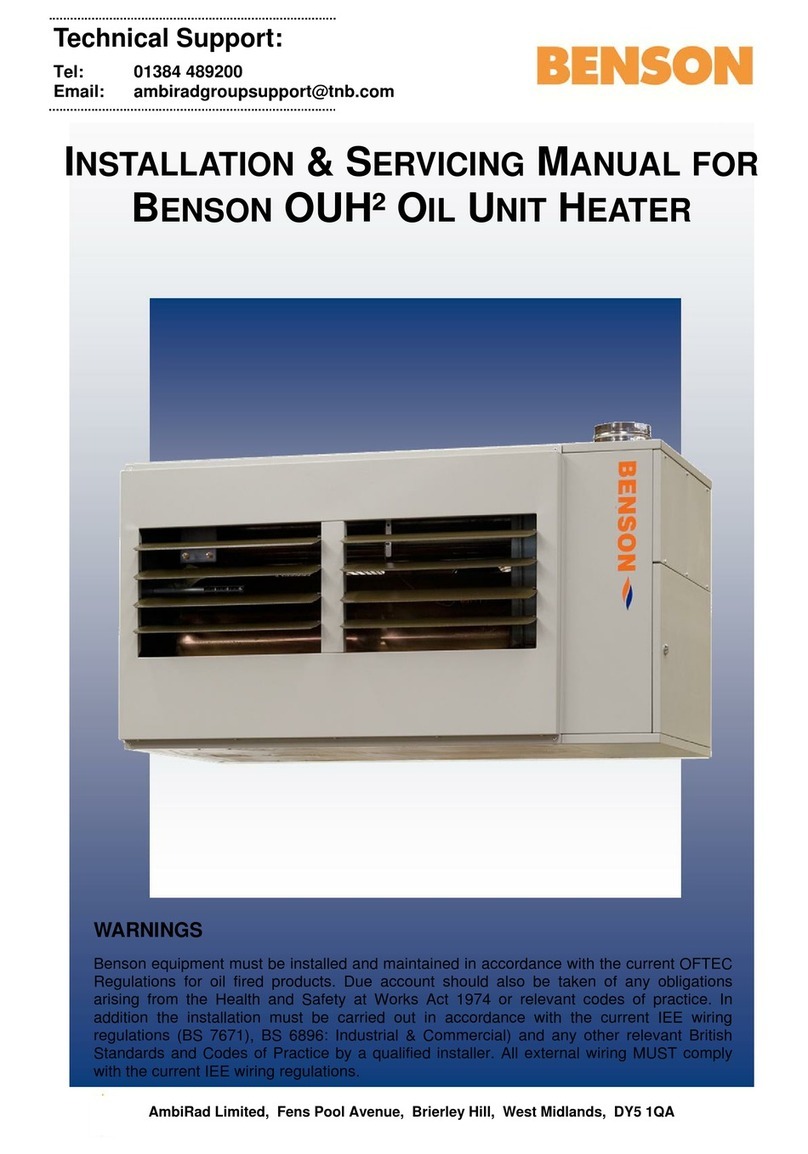
BENSON
BENSON OUHC Series User guide


